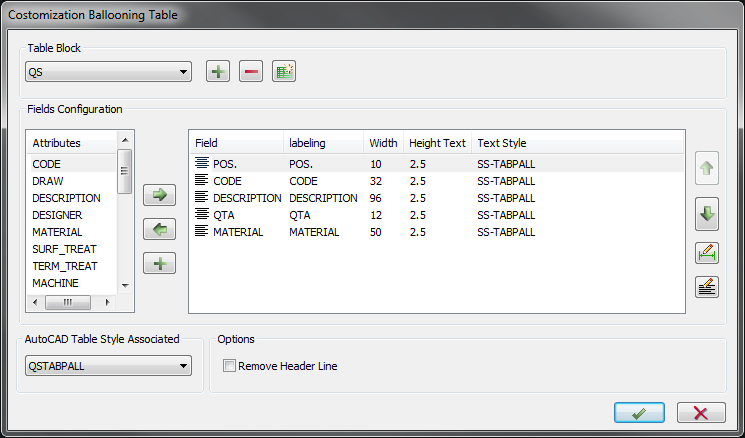Top_TabStyle
Menu: Top > Customize > Balooning table
- What
- Provides the user with a convenient tool for the definition of the table that TOP uses for ballooning. This tool works only on the AutoCAD’s table objects and not on TOP historical block, so you can use it only if you have an AutoCAD 2007 or later and if you plan to use the AutoCAD’s table objects for the ballooning.
- Why
- Allows the user to customize the ballooning table in a simple and functional way.
- How
- By entering the command the dialogue interface below will be shown to the user. From this interface, on top part, we can add or remove "Table Blocks". The name "block" is just a pseudonym used as a leading thread with the old table management through blocks, as it has the same effect. This list of blocks is in fact nothing more than a list of table configurations.
When you add a new block you will be asked for a unique name through a special interface. Once this has been done, a new block will be added but it will be empty. It will be necessary at this point to select from the list of parts attributes, shown on the left, the attributes that we want to have as columns in our block. Each time you add an attribute its column width is set to 0 by default, this means that its width will adapt itself to the content that it will contain. If you want you can force a value by selecting the attribute and by clicking on "Define Width" button, recognizable by the icon with a pencil and a dimension.

We can also assign each column a justification by selecting it in the menu and by clicking on the justification icon, recognizable by a pencil and some lines. At the bottom of the dialogue we can associate to a particular table style the newly defined block. The table style is an AutoCAD object that defines the table formatting with regard to texts arrangement, development direction, colours etc...
Finally, among the options we have the opportunity to draw the table without heading, the ideal if you plan to use this table on title-blocks that already have a heading.